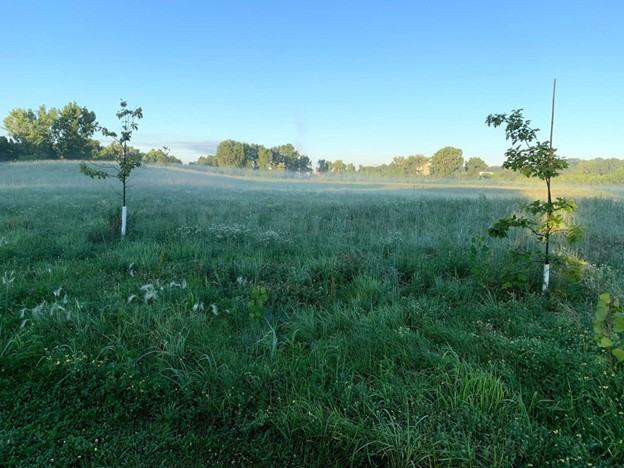By Michael Barnes

A few months ago I wrote an article about the issue with much of the popular media and scientific work done related to ecosystem services of turfgrass greenspaces whereby the majority of efforts in this area have done one of two things, either a) they’ve failed to compare turfgrass to a suitable alternative and/or b) they’ve not included significant portions of the academic literature causing large gaps in the full picture of what turfgrass greenspaces provide. Today though, I’m happy to report that a new review in this area expands both the depth and breadth of understanding the ecosystem services and disservices of turfgrass greenspaces.
Published just this month, “Urban green spaces and sustainability: Exploring the ecosystem services and disservices of grassy lawns versus floral meadows,” by Paudel and States, explores the comparison between these two urban landscapes in a more robust way than the majority of previous reviews. Review articles are those that attempt to summarize the state of the research on a particular topic by synthesizing the findings of previous research articles. Before diving in, for the non-academics and researchers reading, reviews are HARD. They are extremely time consuming, hard to execute, and nearly impossible to get perfectly right for everyone who might come across it. Let me give you just one example. When doing a review, you have to set a time limit, i.e., from what beginning date to what end date do I want to look at. This choice immediately makes a review as accurate as what is available in the literature between those two dates. As after all of the papers are collected, you have to go about organizing and analyzing them which can take months, and that's not including the writing of the actual paper itself. So you can imagine how many new papers came out related to that topic in the intervening time between when your date range ended and when the review was published. There are a multitude of other factors that make reviews difficult, but I hope illustrating that one helps orient you a bit to be a bit more forgiving of review papers in the future. Okay, back to the paper at hand!
I’m not going to go through the review point by point but rather discuss 3 key elements which make this review one to check out.
(1) The review takes into account literature from across a broad range of disciplines. This should seem like common sense, but a lot of reviews are framed from a particular disciplinary perspective. While this isn’t necessarily a negative, it can leave out critical pieces of literature. Turfgrass greenspaces are studied by a variety of folks whose disciplinary specialities often are in turfgrass science, but also often aren’t included. The current review brings in literature that spans from turfgrass scientists to entomologists to urban planning scholars. The disciplinary inclusivity allows for more robust conclusions to be drawn if, for example, a particular ecosystem service is found by researchers across disciplines using a multitude of tools and methods to come to that conclusion. In other words, it's a way of triangulating findings to come to a more comprehensive understanding of what’s actually happening.
(2) The review utilizes the more up-to-date Common International Classification of Ecosystem Services (CICES) framework. This is a bit more of a sciency reason, but one of the things that academics sometimes struggle with is speaking the same language when it comes to a particular concept. In my own area of social science, there are a number of concepts that mean very different things whether you're talking to a psychologist or a sociologist. The CICES framework is a comprehensive, hierarchical classification system for ecosystem services that provides scientists regardless of discipline, a structure and common language to work from. This is crucial when we’re trying to compare findings between papers on the same topic, and also when we’re comparing ecosystem services between different landscapes such as in the current review.
(3) Finally a review has included a more detailed discussion of cultural ecosystem services! One of the biggest things that is missing in the vast majority of work on ecosystem services of turfgrass greenspaces is the lack of or outright exclusion of cultural ecosystem services. Cultural ecosystem services are those that have direct benefits for people–think recreation or stress reduction–and are the primary service provided by turfgrass areas. Going back to the reviews that are disciplinary specific, you can see how perhaps an ecology paper (not to pick on ecologists, just an example) might not include these cultural services, and come to a conclusion that wildly underestimates the total services provided by turfgrass greenspaces because of it.
While the current review has some significant upsides, and is much more comprehensive, there are still some issues; let's discuss just one. While the review does contain a more robust discussion of cultural ecosystem services, there is still significant detail and nuance that could be added to this discussion. I will note that this isn’t entirely the fault of the authors but rather that papers that address such aspects of turfgrass greenspaces can be quite hidden and hard to find. For instance, sometimes papers addressing something like micro parks or youth sports might allude to the presence of turfgrass but don’t outwardly or directly name it even though turfgrass is the surface facilitating such activities and contact with nature. Additionally, there is simply not enough research specifically focused on the cultural ecosystem services of turfgrass, which is needed to provide a more comprehensive analysis of the total ecosystem services it provides.
In summary, the Paudel and States review goes a long way towards remedying issues of past reviews assessing the ecosystem services of turfgrass greenspaces, but more work can and needs to be done to enhance the specificity and robustness of research in this area, especially related to cultural services.